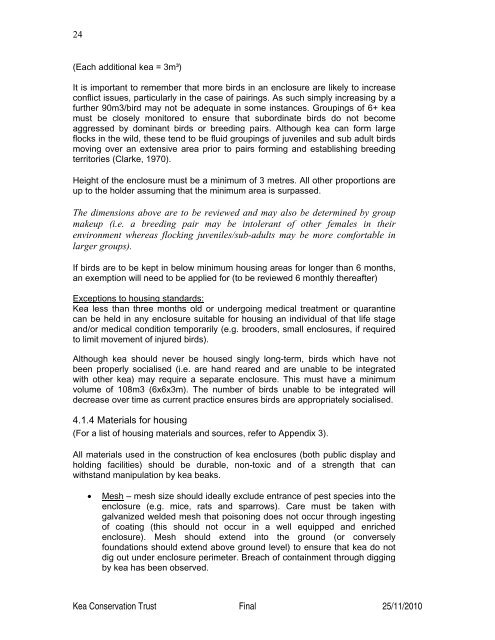(Nestor notabilis) Husbandry Manual - Kea Conservation Trust
(Nestor notabilis) Husbandry Manual - Kea Conservation Trust
(Nestor notabilis) Husbandry Manual - Kea Conservation Trust
Create successful ePaper yourself
Turn your PDF publications into a flip-book with our unique Google optimized e-Paper software.
24<br />
(Each additional kea = 3m³)<br />
It is important to remember that more birds in an enclosure are likely to increase<br />
conflict issues, particularly in the case of pairings. As such simply increasing by a<br />
further 90m3/bird may not be adequate in some instances. Groupings of 6+ kea<br />
must be closely monitored to ensure that subordinate birds do not become<br />
aggressed by dominant birds or breeding pairs. Although kea can form large<br />
flocks in the wild, these tend to be fluid groupings of juveniles and sub adult birds<br />
moving over an extensive area prior to pairs forming and establishing breeding<br />
territories (Clarke, 1970).<br />
Height of the enclosure must be a minimum of 3 metres. All other proportions are<br />
up to the holder assuming that the minimum area is surpassed.<br />
The dimensions above are to be reviewed and may also be determined by group<br />
makeup (i.e. a breeding pair may be intolerant of other females in their<br />
environment whereas flocking juveniles/sub-adults may be more comfortable in<br />
larger groups).<br />
If birds are to be kept in below minimum housing areas for longer than 6 months,<br />
an exemption will need to be applied for (to be reviewed 6 monthly thereafter)<br />
Exceptions to housing standards:<br />
<strong>Kea</strong> less than three months old or undergoing medical treatment or quarantine<br />
can be held in any enclosure suitable for housing an individual of that life stage<br />
and/or medical condition temporarily (e.g. brooders, small enclosures, if required<br />
to limit movement of injured birds).<br />
Although kea should never be housed singly long-term, birds which have not<br />
been properly socialised (i.e. are hand reared and are unable to be integrated<br />
with other kea) may require a separate enclosure. This must have a minimum<br />
volume of 108m3 (6x6x3m). The number of birds unable to be integrated will<br />
decrease over time as current practice ensures birds are appropriately socialised.<br />
4.1.4 Materials for housing<br />
(For a list of housing materials and sources, refer to Appendix 3).<br />
All materials used in the construction of kea enclosures (both public display and<br />
holding facilities) should be durable, non-toxic and of a strength that can<br />
withstand manipulation by kea beaks.<br />
• Mesh – mesh size should ideally exclude entrance of pest species into the<br />
enclosure (e.g. mice, rats and sparrows). Care must be taken with<br />
galvanized welded mesh that poisoning does not occur through ingesting<br />
of coating (this should not occur in a well equipped and enriched<br />
enclosure). Mesh should extend into the ground (or conversely<br />
foundations should extend above ground level) to ensure that kea do not<br />
dig out under enclosure perimeter. Breach of containment through digging<br />
by kea has been observed.<br />
<strong>Kea</strong> <strong>Conservation</strong> <strong>Trust</strong> Final 25/11/2010












